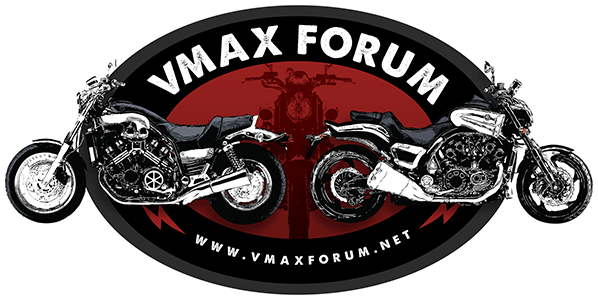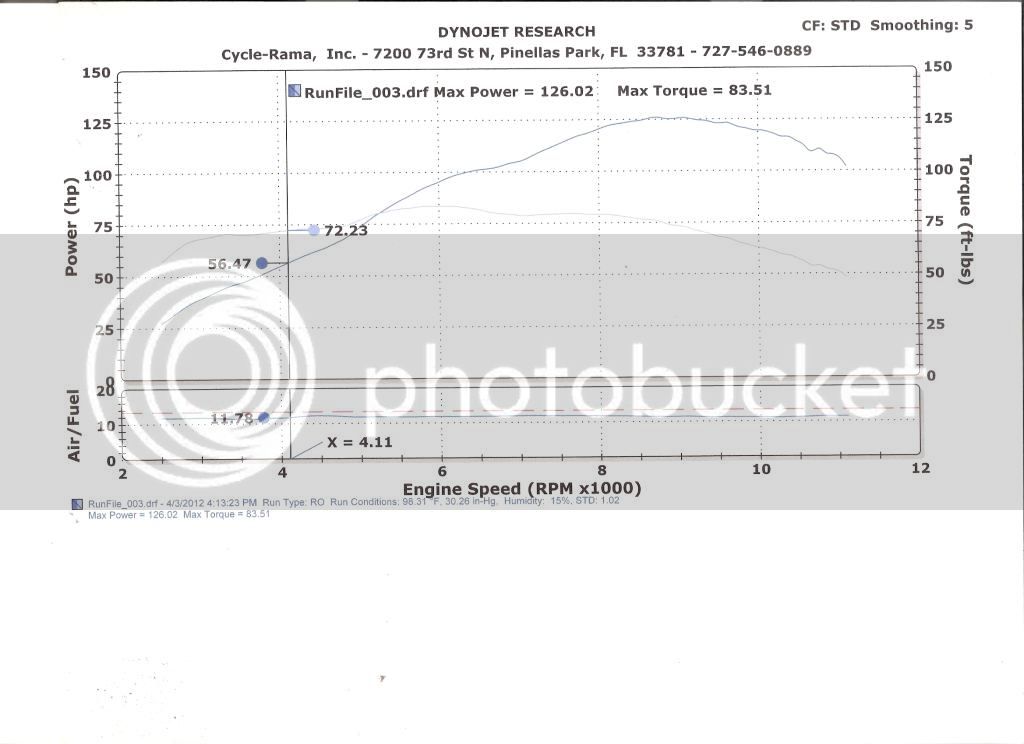You are using an out of date browser. It may not display this or other websites correctly.
You should upgrade or use an alternative browser.
You should upgrade or use an alternative browser.

Help Support VMAX Forum:
This site may earn a commission from merchant affiliate
links, including eBay, Amazon, and others.
Thank you very much for the recognition. LOL.....you know me....just never satisfied, and always want to know why....and how.

$14.39
$15.99
ROCKBROS Windproof Thermal Balaclava Ski Mask for Cycling, Running, Skiing - Men's and Women's
ROCKBROS USA

$13.99
$14.99
Marsrut 3Pcs Motorcycle Valve Adjustment Wrench Tool, Universal Engine Screw Sleeve Spanner 8mm/9mm/10mm Metal Set
Study Kitchen
Well like I told John Blaid.....the Vmax is a cruel mistress. She wants your time....your love....and your MONEY.
customizedcreationz
Well-Known Member
Dyno's are weather finicky. So if you have a cooler day, you'll make more power than a humid day. Sometimes that amount can be pretty darn substantial.
Dyno's are fun though!
Dyno's are fun though!
Here was some info that I found from another site.
I borrowed this a cobalt forum, it explains it pretty good. SAE is the standard.
There are few standards used in the dyno world for gathering HP and TQ numbers, UNCORRECTED, SAE and STD. Uncorrected is NEVER accepted in the world of dynoing and tuning as it does not factor in any weather conditions etc. Now here is where the big debate comes...is between SAE and STD. SAE (Society of Automotive Engineers) is the MOST ACCURATE AND WIDELY ACCEPTED FORM OF MEASUREMENT when it comes to the world of dynoing. Here is some more info I have gathered between the two.....
A lot of people have been asking about SAE .vs STD Dyno numbers so I thought this would help. Most people know that showing STD numbers read higher but not many know why. SAE represents more realistic standard conditions, STD artificially boosts numbers.
Identifying Your Correction Factor:
Dynojet:
If you look at a dynojet graph in the upper right corner, you will see where it says the correction method being used. The options are SAE, STD, Uncorrected and a few not needed for discussion. You will also notice a smooth factor (up to 5) which dyno operators use to make the power curves and any other data displayed, such as AFR, seem more accurate and smooth. You will also see AFR graphs scaled DOWN to hide flaws in the curve.
MD:
A Mustang Dyno ONLY uses SAE Corrections. Smoothing can also be controlled as well as scale for the Graphical Outputs.
Overview:
Most of the stated horsepower numbers are “Corrected” values. The correction standards were developed to discount the observed horsepower readings taken at different locations and weather conditions. It is obvious that an engine builder in Colorado could not produce as much horsepower as a shop at sea level. There is just less oxygen for the engine to burn at the higher altitude. What are less obvious are the other weather condition effects on the engine. So in order to compensate for this all advertised horsepower is “corrected” to several different industry standards.
SAE:
"SAE (Society of Automotive Engineers), USA. Power is corrected to reference conditions of 29.23 InHg (99 kPa) of dry air and 77 F (25°C). This SAE standard requires a correction for friction torque.
STD:
STD is Another power correction standard determined by the SAE. Power is corrected to reference conditions of 29.92 InHg (103.3 kPa) of dry air and 60 F (15.5°C). Because the reference conditions include higher pressure and cooler air than the SAE standard, these corrected power numbers will always be about 4 % higher than the SAE power numbers. Friction torque is handled in the same way as in the SAE standard."
Here is some quick math (using assumptions and round numbers):
STD:
Air Temperature: 60F
Absolute Pressure: 29.92 inches Hg
Relative Humidity: 0%
Relative Horsepower : 104.8%
Air Density: 1.223kg/m3
Relative Air Density: 99.8%
Density Altitude: 67feet
Virtual Temperature: 60F
Vapor Pressure: 0 inches Hg
Dyno Correction Factor: .955
SAE:
Air Temperature: 77F
Absolute Pressure: 29.23 inches Hg
Relative Humidity: 0%
Relative Horsepower : 100%
Air Density: 1.157kg/m3
Relative Air Density: 94.4%
Density Altitude: 1952feet
Virtual Temperature: 77F
Vapor Pressure: 0 inches Hg
Dyno Correction Factor: 1
I borrowed this a cobalt forum, it explains it pretty good. SAE is the standard.
There are few standards used in the dyno world for gathering HP and TQ numbers, UNCORRECTED, SAE and STD. Uncorrected is NEVER accepted in the world of dynoing and tuning as it does not factor in any weather conditions etc. Now here is where the big debate comes...is between SAE and STD. SAE (Society of Automotive Engineers) is the MOST ACCURATE AND WIDELY ACCEPTED FORM OF MEASUREMENT when it comes to the world of dynoing. Here is some more info I have gathered between the two.....
A lot of people have been asking about SAE .vs STD Dyno numbers so I thought this would help. Most people know that showing STD numbers read higher but not many know why. SAE represents more realistic standard conditions, STD artificially boosts numbers.
Identifying Your Correction Factor:
Dynojet:
If you look at a dynojet graph in the upper right corner, you will see where it says the correction method being used. The options are SAE, STD, Uncorrected and a few not needed for discussion. You will also notice a smooth factor (up to 5) which dyno operators use to make the power curves and any other data displayed, such as AFR, seem more accurate and smooth. You will also see AFR graphs scaled DOWN to hide flaws in the curve.
MD:
A Mustang Dyno ONLY uses SAE Corrections. Smoothing can also be controlled as well as scale for the Graphical Outputs.
Overview:
Most of the stated horsepower numbers are “Corrected” values. The correction standards were developed to discount the observed horsepower readings taken at different locations and weather conditions. It is obvious that an engine builder in Colorado could not produce as much horsepower as a shop at sea level. There is just less oxygen for the engine to burn at the higher altitude. What are less obvious are the other weather condition effects on the engine. So in order to compensate for this all advertised horsepower is “corrected” to several different industry standards.
SAE:
"SAE (Society of Automotive Engineers), USA. Power is corrected to reference conditions of 29.23 InHg (99 kPa) of dry air and 77 F (25°C). This SAE standard requires a correction for friction torque.
STD:
STD is Another power correction standard determined by the SAE. Power is corrected to reference conditions of 29.92 InHg (103.3 kPa) of dry air and 60 F (15.5°C). Because the reference conditions include higher pressure and cooler air than the SAE standard, these corrected power numbers will always be about 4 % higher than the SAE power numbers. Friction torque is handled in the same way as in the SAE standard."
Here is some quick math (using assumptions and round numbers):
STD:
Air Temperature: 60F
Absolute Pressure: 29.92 inches Hg
Relative Humidity: 0%
Relative Horsepower : 104.8%
Air Density: 1.223kg/m3
Relative Air Density: 99.8%
Density Altitude: 67feet
Virtual Temperature: 60F
Vapor Pressure: 0 inches Hg
Dyno Correction Factor: .955
SAE:
Air Temperature: 77F
Absolute Pressure: 29.23 inches Hg
Relative Humidity: 0%
Relative Horsepower : 100%
Air Density: 1.157kg/m3
Relative Air Density: 94.4%
Density Altitude: 1952feet
Virtual Temperature: 77F
Vapor Pressure: 0 inches Hg
Dyno Correction Factor: 1
I need to get back and make a dyno run on Skullduggery with the air box lid off. I'm running way rich here and by looking at the plugs. 147.5 Jets,
30 thousandths shims. Basically stock carbs air box and a Kerker with a 12" marks can. Some motor work. Wonder if I can get 2 HP or maybe a little more? The bike may even run stronger?:ummm:

30 thousandths shims. Basically stock carbs air box and a Kerker with a 12" marks can. Some motor work. Wonder if I can get 2 HP or maybe a little more? The bike may even run stronger?:ummm:

After I talked to Maleko89 last night, he said that the Vmax makes the best hp with an A/F of 13.75-14.25.
PO Mods include (Undocumented) except (Word of Mouth) being done 11,000 miles ago: The bike had PART of a stage 4 kit installed when I bought it and it ran like crap. I took the stage 4 out and tuned the engine with basically stock carbs.
Higher compression (it doesn't like Ethanol anything or anything below 90 octane).
Oil Pump Mod., the output is 7-8 pounds higher than my 94. This includes updated piping and COO Mod.
Possibly undercut gears, Shifting is simply like cutting butter with a hot knife.
It runs way different than my 94 which has lots of mods (Including Ignition) too.:confused2:
Higher compression (it doesn't like Ethanol anything or anything below 90 octane).
Oil Pump Mod., the output is 7-8 pounds higher than my 94. This includes updated piping and COO Mod.
Possibly undercut gears, Shifting is simply like cutting butter with a hot knife.
It runs way different than my 94 which has lots of mods (Including Ignition) too.:confused2:
I wonder if its actually a 1260? That would make sense with those numbers and mods.
DMAN999
Well-Known Member
SpecOps,
I think the PO may be a bit confused, so take what he said with a grain of salt.
There is No Stage 4 kit for our bike.
DynoJet only makes a Stage 1 and Stage 7 kits for a Vmax. http://www.dynojet.com/jetkits/motorcycle/yamaha.aspx
They don't make a Stage 4 kit for any bike that I can find.
And Factory Pro offers Standard or Titanium kits
http://www.factorypro.com/Prod_Pages/prody11.html
I think the PO may be a bit confused, so take what he said with a grain of salt.
There is No Stage 4 kit for our bike.
DynoJet only makes a Stage 1 and Stage 7 kits for a Vmax. http://www.dynojet.com/jetkits/motorcycle/yamaha.aspx
They don't make a Stage 4 kit for any bike that I can find.
And Factory Pro offers Standard or Titanium kits
http://www.factorypro.com/Prod_Pages/prody11.html
SpecOps,
I think the PO may be a bit confused, so take what he said with a grain of salt.
There is No Stage 4 kit for our bike.
DynoJet only makes a Stage 1 and Stage 7 kits for a Vmax. http://www.dynojet.com/jetkits/motorcycle/yamaha.aspx
They don't make a Stage 4 kit for any bike that I can find.
And Factory Pro offers Standard or Titanium kits
http://www.factorypro.com/Prod_Pages/prody11.html
Dennis, agreed. A lot of owners used to call it a stage 4 when you used stage 7 kit but just modified the air box instead of using individual filters. DJ never sold a stage 4 kit as far as I know.
Nice numbers! That there should be taped to your fridge!
I need to get back and make a dyno run on Skullduggery with the air box lid off. I'm running way rich here and by looking at the plugs. 147.5 Jets,
30 thousandths shims. Basically stock carbs air box and a Kerker with a 12" marks can. Some motor work. Wonder if I can get 2 HP or maybe a little more? The bike may even run stronger?:ummm:

Similar threads
Parts For Sale
Optimal Carbone x pipe for Vmax 1700
- Replies
- 0
- Views
- 193
Parts Wanted
Kerker 4-1
- Replies
- 3
- Views
- 506
- Replies
- 15
- Views
- 2K















![Aomiker Motorcycle Phone Holder Mount - [Metal Extension Arm] [Dual Vibration Dampener] Motorcycle Cell Phone Mount, Bike Phone Handlebar Clamp for iPhone 16 15 14 13 Pro Max Plus, 4.7-6.7" Smartphone](https://m.media-amazon.com/images/I/51gU2g5VxgL._SL500_.jpg)







![Lamicall Motorcycle Phone Mount Holder - [Dual Vibration Dampener] [720° Adjustment Arm] Motorcycle Cell Phone Holder, Bike Handlebar Phone Mount, for iPhone 16/15/ 14/13 Pro Max, 4.7-6.7" Phones](https://m.media-amazon.com/images/I/41g9IDInCIL._SL500_.jpg)







![Bovemanx Motorcycle Phone Mount Holder, [150mph Wind Anti-Shake][7.2inch Big Phone Friendly] Bike Phone Holder, Motorcycle Handlebar Cell Phone Clamp, Compatible with iPhone 16 Pro Max Smartphones](https://m.media-amazon.com/images/I/51F+1sontPL._SL500_.jpg)